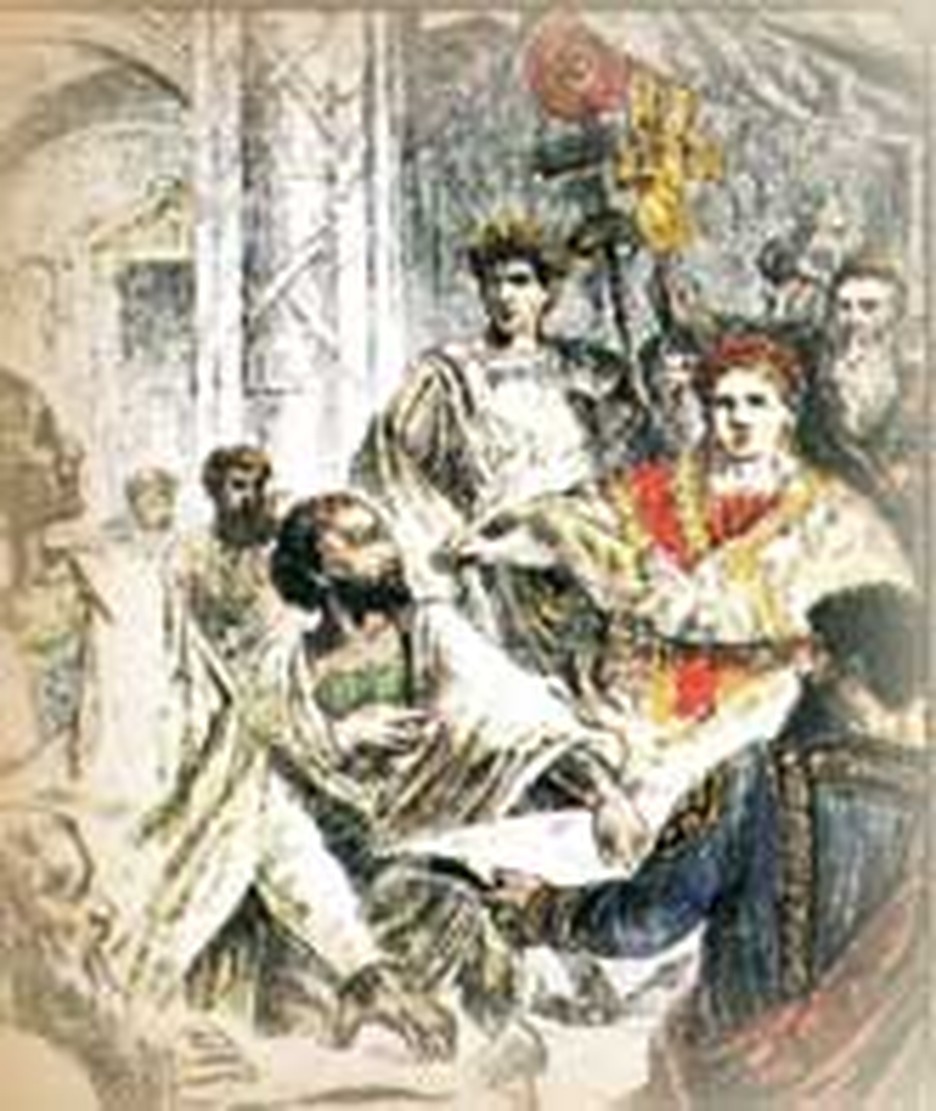
Blinding Ignorance does mislead us. O! Wretched mortals, open your eyes!" Leonardo Da Vinci, quoted in The Da Vinci Code, p. 231
In every age, there have been attacks on Jesus and the teaching of Scripture. Jesus has been an offense to the world from the very beginning. One recent attack is particularly beguiling because it is so entertaining. It's author, Dan Brown, brashly assures us his account is based on the actual historical facts. But The Da Vinci Code paints either an uninformed or intentionally false picture of the early church. In this issue, we want to show you why.
The Da Vinci Code is a suspense thriller and runaway bestseller in which the reader discovers that a modern-day murder is the result of an on-going, 2,000 year cover-up by the church in an attempt to hide the true origins of Christianity. The movie version of the book, starring Tom Hanks, is scheduled to be released sometime in 2006. The questions and doubts the novel has raised are an indication of how ahistorical our culture has become. It also indicates how uninformed many Christians are about early church history. Brown's character Teabing was right about one thing: "Blinding Ignorance does mislead us." As we will see below, it is The Da Vinci Code that turns out to be the distortion and re-writing of history.
The Claims
Chapter 55 of Brown's thriller opens with the fictional character Teabing asserting with scholarly confidence: "Nothing in Christianity is original. . .virtually all the elements. . .were taken directly from earlier pagan mystery religions. . .The Bible is a product of man, my dear. Not of God. . ..Who chose which gospels to include? . . . [T]he pagan Roman emperor Constantine. . . [U]ntil the [Council of Nicea in A.D. 325], Jesus was viewed by His followers as a mortal prophet. . . [E]stablishing Christ's divinity was critical to [Constantine for] the further unification of the Roman empire and to the new Vatican power base. . .the earlier gospels were outlawed, gathered up and burned. . .the modern Church's desire to suppress these documents comes from a sincere belief in their established view of Christ."
Ironically, as we will see below, it is The Da Vinci Code that turns out to be the rewriting of history. Therefore, Christians should not feel threatened by its claims. Instead, we should grasp the wonderful opportunity we have been given to explore the historical roots of our beliefs and to share the gospel with those whose curiosity has been aroused by the book.
Here are three major claims made in The Da Vinci Code about church history: 1. Christians did not view Jesus as divine until after the Council of Nicea. 2. Constantine or the Vatican suppressed the earlier, truer gospels to consolidate power. 3. The church covered up the fact that Jesus and Mary Magdalene had a child together, because that would have proved that Jesus was only a "mortal prophet."
The novel then argues that the church continued to lie to protect these secrets right up to the present day. However, if these three arguments are proven false, then there is no secret that needs to be hidden and The Da Vinci Code's entire conspiracy charge crumbles. Because history cannot be repeated like a science experiment, figuring out what actually happened is more like a legal case--evidence must be weighed to determine the most reasonable explanation based on the known facts.
Did Early Christians Think Jesus Divine?
During Christianity's first three centuries, churches formed around the large cosmopolitan areas of the ancient world. There was no Vatican, no Catholic Church, and no central authority defining beliefs. Each region appointed its own church leaders and developed its own understandings of the Christian faith. In fact, Popes did not have much power until the Holy Roman Empire of Charlemagne around A.D. 754. The Council at Nicea in A.D. 325 was called by the emperor, Constantine, in response to pre-existing disputes. It was the first of seven ecumenical councils held between A.D. 325 and 787. The leaders of these groups from different regions came together to decide what they could agree on in Christianity. Despite their theological differences, they did agree that Jesus was much more than a human being. Prior to Constantine there was no possible advantage to claiming Jesus was God, as the earliest Christians did. Quite the contrary--it could cost you your life.
Based on manuscript evidence, both conservative and liberal scholars agreed on the following things: 1. They agree that Paul wrote the book of Romans before the year A.D. 59 (long before the "secret" gospels mentioned in The Da Vinci Code were written and over 265 years before the Council of Nicea). Paul wrote in Romans 8:9, "What the Law could not do, weak as it was through the flesh, God did: sending His own Son in the likeness of sinful flesh." (Romans 8:3) 2. They agree that Colossians, written some time between A.D. 57 and 80, says "[Jesus] is the image of the invisible God. . .For by [Jesus] all things were created. . .For God was pleased to have all his fullness dwell in him." 3. They agree that the book of Hebrews was written well before A.D. 70. The author leaves us in little doubt when writing in Hebrews 1:1-3 "God, after He spoke long ago. . .has spoken to us in His Son. . .And He is the radiance of His glory and the exact representation of His nature. . ."
Around A.D. 107, Ignatius wrote that Jesus was "God Incarnate. . .God himself appearing in the form of a man." About A.D. 177, Medito of Sardis wrote of Jesus, "He was man, yet He is God. . ." Long before the Nicean creed, local creeds and baptismal formulas reflected a core set of beliefs referred to as the "Rule of Faith." The world's foremost authority on ancient Christian creeds, Jaroslav Pelikan of Yale University, states that the unity of these earliest pre-Nicean creeds could be summed up this way: "The one true God, Creator of heaven and earth; His only Son, born of the Virgin Mary, divinely powerful in word and deed, crucified under Pontius Pilate, raised from the dead, and returning to judge the world."
In other words, the truth lived out in the lives of the early Christians and expressed through the writings of their leaders is the exact opposite of the argument made in The Da Vinci Code. Evidence shows that the vast majority of early Christians believed Jesus was no mere mortal prophet. In fact, the debate at Nicea was not whether Jesus was human or God; it was over exactly how divine He was. Even minority dissenters led by Arius didn't think Jesus was simply a human being. They thought Jesus was "God the only-begotten," who had existed since the beginning of the world.
The majority of Christians were so convinced that Jesus was divine that many were willing and did lay down their lives for this belief. Whether Constantine's motives were political, spiritual, or both, the council he arranged drew from the beliefs already present in the communities. He did not, as Brown claims, create and pass on new beliefs from the top down.
Were the Earliest Gospels Suppressed?
As we have seen, prior to Constantine, there was no centralized power declaring which gospels should be considered scripture and which should not. Instead, regional churches established their own lists of authoritative scripture based on their own experiences of the risen Lord. Despite some differences, there was incredible agreement on the gospels from the start. The four Gospels--Matthew, Mark, Luke, and John--were included in every major list. The gospels listed in The Da Vinci Code were not.
In Southern France before A.D. 181, Irenaeus, bishop of Lyons declared, "It is not possible that the Gospels can be either more or fewer in number than they are. . ." In North Africa around A.D. 206, church father Tertullian accepted only the four gospels. In Egypt before A.D. 254, scholar and teacher Origen accepted only the four gospels. Origen traveled extensively, noting which scriptures were read in various regions. Sometime between A.D. 244 and 254, he wrote that Matthew, Mark, Luke and John "are the only indisputable ones in the church of God under heaven. . .we have approved solely what the church has recognized, which is that only the four Gospels should be accepted."
Thus, the four gospels were chosen because they had already proven true to the dispersed churches, not because Constantine was attempting to consolidate power. If this had been the case, the differing perspectives of the four gospels would most likely not have been included. A true political cover up would have come up with a single party-line gospel to avoid apparent inconsistencies. The vast majority of scholars today are convinced that the rejected gospels mentioned in The Da Vinci Code were not written earlier than Matthew, Mark, Luke, and John. In fact, they were actually written much later. However, even if they had been written earlier, the vast majority of local churches and Christians had already rejected them as false prior to the time of Constantine.
Did Jesus and Mary Magdalene have a Child?
There is no historical evidence that Jesus was ever married or had children. But even if He had, there would be no theological reason to hide it. The council of Nicea, which Brown's characters claim invented Christ's divinity, is the very one that also pointed out his humanity. The Nicean Creed says explicitly that Jesus "was made man" or "became truly human." Jesus was not God in disguise--He had the full nature of God plus the full nature of humanity. In fact, if the cover up was to make Jesus look more divine, one would expect that the ecumenical councils that followed Nicea would have obscured Christ's humanity. Instead, they clarify and expand His humanness. For example, at the Council of Chalcedon in A.D. 451, the churches declared that Jesus was both God and man. He was "complete in manhood. . .truly a man. . .like us in all respects (apart from sin) . . . [because his] two natures [are] without confusion." There was nothing magical or special about Jesus' body or blood. He did not have a secret power running through his veins--He was the power. If He had married and fathered a child, it would have simply been a human child born of His human nature. It would in no way challenge or diminish His divinity. As hard as it might be for any of us to grasp how Jesus could have two natures, no one can deny that this is exactly what was believed by the creed writers--the very people The Da Vinci Code claimed were trying to cover up Christ's humanity.
Conclusion
So while the list of agreed upon scriptures developed over time, just as the church's understanding of Jesus matured over time, we can see a common thread running from the earliest Christians right up to this day. This shared belief is summarized in the Apostles' Creed and further refined in the Nicean creed. In other words, the truth that breaks The Da Vinci Code--the fact that Jesus was both fully God and fully human--has been hidden in plain sight all along. For almost 2,000 years it has been on the lips of Christians as they have repeated the ancient creeds of the church! Thus, there was never a reason to hide any aspect of Jesus' humanity. His humanity has never been a threat to the church in all of its history. However, His divinity has always been a threat, and an offense to those who do not accept the Gospel.
The Da Vinci Code Deception DVD
This docudrama answers the lingering questions and exposes the deceptions in Dan Brown's novel through interviews with book authors and leading experts. Contact Vision Video at 1-800-523-0226 or go to www.visionvideo.com.
Resources:
- Bock, Darrell L. Breaking the Da Vinci Code.
- Habermas, Gary R. The Historical Jesus.
- Metzger, Bruce. The Canon of the New Testament.







